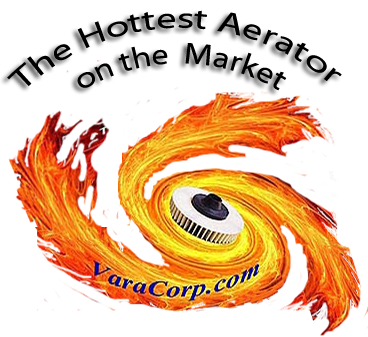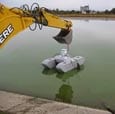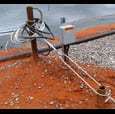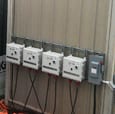Tech Specifications

VaraCorp is Setting a new standard in surface aeration
VaraCorp is setting a new standard in aeration by providing a state-of-the-art wastewater aerator which employs a rotating turbine. This aerator overcomes many of the shortcomings of competing aerators. The aerator boasts simplicity, durability, little-to-no maintenance, and air transfer performance. The aerator is made of lightweight material which is both wear and corrosion-resistant. Its capital costs are low compared to most aerators in its class. Plus, its power consumption is as much as 50% less than aerators of similar performance.
Motor Specifications
The standard motor used on the VaraCorp aerator is rated at 5 horsepower, 220/440 volts, 60 Hz, three-phase, industrial duty, epoxy coated, totally enclosed-fan cooled (TEFC) with rain cap. We often can provide other motors if needed to meet specific client needs. Examples are single-phase, 3 horsepower, 120 volt or 575 volt motors, etc.
Our motors are custom-made in America to VaraCorp’s specifications by the Baldor Motor Company via Austn Armature Works. Since all of the modifications to the motors are made by Baldor, there is no conflict with after-market modifications that might violate warranty guidelines.
Air/Drive Shaft Specifications
Each air/drive shaft is made from 316 stainless steel tubes with an outside diameter of 1½-inches. These shafts are cut, polished, straightened, drilled, and tapped by master machinists using a state-of-the-art Haas 40L CNC. Each shaft is quality tested for straightness before shipment. The standard length of the air shaft is 3 ½ feet. This length typically will place the rotating turbine about 2 ½ feet below the water surface when mounted on VaraCorp’s floating pontoons.
Other lengths of air shafts can be special ordered up to 6 feet. Note that a 3 ½-foot air shaft can push dissolved oxygen downward about 10 feet below the water surface, so longer lengths are rarely needed.
Turbine Specifications
The diameter of the turbine is 8 inches. The height of the turbine with the air shaft coupling is about 4 inches. All models of the aerator use this same size turbine. The turbine is made of high density nylon impregnated with 30% fiberglass making it both wear and corrosion resistant. (Differences in performance are achieved by using different motor RPM and air shaft lengths.)
Pontoon Specifications
VaraCorp’s pontoons consist of polyethylene jackets that surround a closed-cell foam inner core. These pontoons are guaranteed not to sink under normal wear and tear. The jacket is ¼-inch nominal thickness and is treated for UV protection. A foam-filled polyethylene deck mounts between the two pontoons to support the motor. When assembled with a motor deck, the floating pontoon system is 68 inches long, 44 inches wide, and 18 inches tall. The weight of the pontoons without the motor, air shaft, or turbine is 140 pounds. The pontoons are manufactured by VaraCorp in the U.S.
Low Water Legs
Some waste lagoons have fluctuating water levels making it imperative that legs be installed beneath the floating pontoons. VaraCorp’s pontoons can be fitted with four polyethylene legs. These legs keep the spinning turbine from striking either the mud bottom of the lagoon or the plastic liner in the lagoon.
Debris Sleeve
Some waste lagoons are notorious for having strings, rags, or other debris that wreak havoc on all sorts of aerators. While it is difficult for rags to wrap around VaraCorp’s smooth stainless steel air shaft rotating at 1800 rpm, we still recommend that a debris cover, sometimes called a debris sleeve, be installed if rags are present in the wastewater. This debris sleeve, a 5-inch circular tube made of polyethylene, attaches to the bottom of the motor deck and completely encircles the entire length of the air shaft.
A circular leather “boot” is clamped to the bottom of the debris sleeve just above the rotating turbine. This boot can inhibit strings and rags from entering the gap between the sleeve and the turbine.
Installing the Turbine Aerator
Assembling the aerator and pontoons is quick and simple
VaraCorp provides assembly and installation instructions with each sale. Basically, the pontoons snap together and are held in place with bolts and embedded nuts. Once the pontoons are assembled, the motor is bolted to the motor deck. Afterwards, the pontoons are lifted into the air by a backhoe or crane truck, and the air shaft and turbine are then assembled and installed onto the motor shaft.
Next, the legs and/or debris cover is installed if needed. After the final assembly, the entire aerator is lifted and dropped into the water with great care being taken not to lift the aerator by the air shaft or to drag the turbine in the mud along the shoreline.
Installing Methods

Launching the aerator
A backhoe or bucket truck can easily be used to launch the aerator.

Guy wire anchoring
The turbine puts out a 360-degree thrust, so very little anchoring for the guy wires is needed. A simple post on the shore generally is all that is needed.

Control panel box
The electrical panel boxes are pre-wired and can be installed on a post or a wall.
